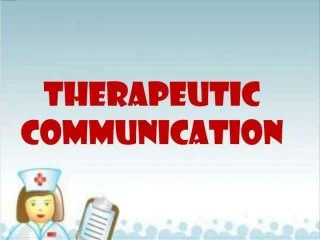Therapeutic communication is the process of communicating with someone who has a mental illness, to help them to improve their health and well-being. It is a way of helping people who ill understand what they can do to manage their illness, and how they can get better.
Techniques of Therapeutic Communication:
There are a lot of techniques for Therapeutic Communication such as using silence, accepting, active listening, and making the observation.
8 Goal Of therapeutic communication
- Growing Trust
The communication style of doctors and nurses and their connections with patients. Most people value a kind, empathetic, and privacy-respecting physician when discussing health concerns, fears, and prognoses.
Patients need to be able to rely on their medical team. Otherwise, they may not receive important information or may not be able to relax in the office or hospital. This is one of the most important goals of the 8 goals of therapeutic communication.
- Continuous Learning
Therapeutic communication helps promote continuous learning and growth by helping caregivers empathize, listen, and raise awareness. Communicating with a diverse patient base helps caregivers become more empathetic and aware of the unique challenges facing patients. These interactions build over time and help caregivers become more effective and empower to connect with their patients. This was the second goal out of 8 goals of therapeutic communication.
- Creating Patients’ Understanding of Well-being Concerns & Openings
Therapeutic communication is key to making a difference for patients to feel secure and comfortable while they’re within the clinic or clinic. But it can also be utilized to assist individuals to live way better, more beneficial lives. This is one of the most important out of the 8 goals of therapeutic communication.
- Making a connection with the patient
It is the most underrated goal out of the 8 goals of therapeutic communication. There are numerous different communication methods medical caretakers can utilize when working with patients. But within the conclusion, the foremost vital objective of helpful communication is association.
- Give Patients with Significant Unwinding Methods
The fifth goal out of the 8 goals of therapeutic communication is patients may get to be disturbed or frozen amid their remain, which may jeopardize their advance and well-being or indeed cause a security issue. Nurture who gets how to communicate successfully with patients, be that as it may, can offer assistance in these situations.
- Overseeing Behaviors
Patients aren’t continuously in a great state of intellect when they’re in a therapeutic office and some of the time act out. They may be encountering a mental well-being crisis or they might essentially be in torment or frightened. Furthermore, their family individuals might show issue practices since they are irate, anxious, and concerned almost their adored one.
- Identify the strengths and weaknesses of Patients.
Therapeutic communication helps doctors to understand of strengths and weaknesses of patients. According to their behavior and their way of having conversations. This was the seventh goal out of 8 goals of therapeutic communication.
- Clarify areas of conflict and fear
The 8th goal out of 8 goals of therapeutic communication. In Therapeutic communication, doctors need to understand the area of conflict and the area of fear so that they can prescribe an accurate technique to improve their condition.
Conclusion
For effective therapeutic communication, nurses must consider privacy and respect with the use of boundaries, touch, monitoring, and active listening.
Read More at Ureadit.com



